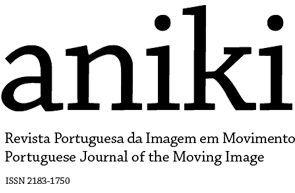Introduction to the Special Section: Methodological and conceptual challenges in cinematic Arts-Based Research
Abstract
This Speçcial Section of Aniki journal addresses the methodological and conceptual challenges posed to Arts-Based Research in the field of cinematic arts. This type of research, still in consolidation, intersects arts, sciences, and the humanities, proposing an ecology of practices that value creation as a form of knowledge. Practice-based artistic research challenges traditional academic norms by introducing hybrid, interdisciplinary, and speculative methods, expanding the epistemological and aesthetic scope of research. The Section brings together five articles selected from various submissions, highlighting the socio-cultural impact of artistic practices in audiovisual media. Júlia Rodrigues analyzes the film A Media Voz (2019), by Heidi Hassan and Patricia Pérez, as a poetic autoethnography of exile and identity. Brian McKenna discusses how audiovisual technologies, while enabling, can restrict artistic autonomy if not critically appropriated. Vivian Castro Villarroel proposes the audiovisual essay as a method to explore memories of deindustrialization, intertwining image, sound, and archive. Tania de León investigates virtual reality drawing as an immersive and somatic gesture, rethinking presence and the body as creative agents. Finally, Diana Toucedo, through the lens of film editing as a political act, writes a text in which creativity is described as the ability to be touched by wonder and the desire to respond to what astonishes us. This set of reflections emphasizes the ability of cinema and visual arts to generate sensitive, political, and situated knowledge, promoting the emergence of new languages and methodologies. Thus, the dossier reaffirms the potential of artistic research not only to transform creation itself, but also the ways of receiving and studying it, opening space for counter-hegemonic, decolonial, feminist, queer, and ecological epistemologies.
References
Boomgaard, Jeroen, and Katie Clarke. 2022. Hinterlands: How To Do Transdisciplinarity. Amsterdam: ARIAS Amsterdam.
Cotter, Lucy. 2019. Reclaiming Artistic Research. Berlin: Hatje Cantz.
Deleuze, Gilles. 1985 L'image-temps. Cinéma 2. Paris: Les Éditions de Minuit.
Fuller, Matthew and Eyal Weizmann. 2021. Investigative Aesthetics: conflicts and Commons in the Politics of Truth. London and New York: Verso Books.
Henke, Silvia and Dieter Mersch, Nicolaj van der Meulen, Thomas Strässe, Jörg Wiesel. 2020. Manifesto of Artistic Research - A Defense Against its Advocates. Zurich: Diaphanes.
Manzano Águila, J., et al. 2017. Estrategias creativas para el dibujo en entornos de realidad virtual. Facultad de Artes y Diseño de la Universidad Nacional Autónoma de México. http://dibujovirtual.rua.unam.mx.
Pedrosa, Mário. 1967. “O 'bicho-da-seda' na produção em massa.” In Mundo, homem, arte em crise, edited by Aracy Amaral, 109–13. São Paulo: Perspectiva, 1975.
Pareyson, Luigi. 1984. Os problemas da estética. São Paulo: Martins Fontes.
Smith, Hazel, and Dean, Roger. 2010. Practice-led Research, Research-led Practice in the Creative Arts, Edinburgh: Edinburgh University Press.
Stengers, Isabelle. 2005. “Introductory Notes on an Ecology of Practices.” Cultural Studies Review 11 (1): 183–96. https://epress.lib.uts.edu.au/journals/index.php/csrj/issue/view/165.





